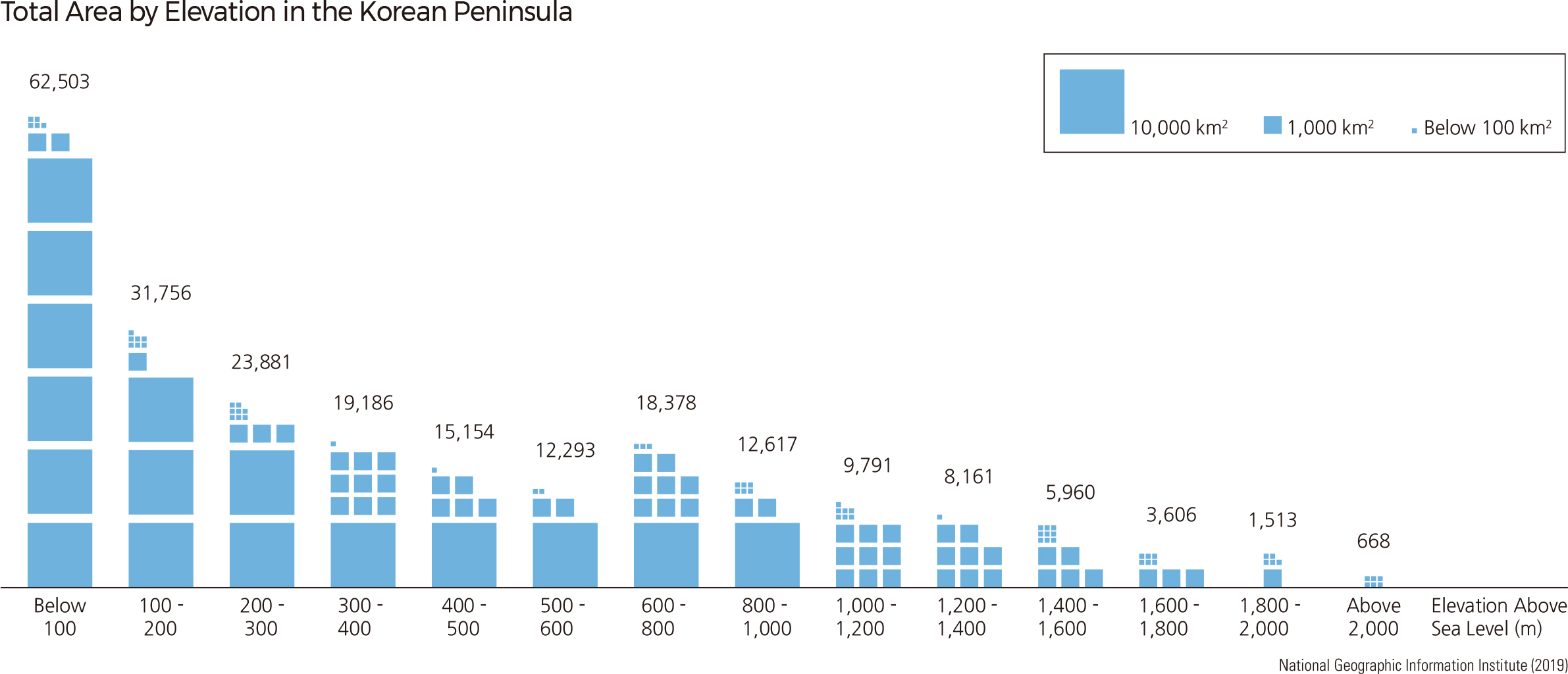English II 2020
The Korean Peninsula is surrounded by water on three sides. In contrast to its smooth eastern coastline, its southern and western coastlines are extremely complex. The Peninsula has relatively long coastlines for its size. According to a 2014 survey, the total coastline of the mainland is 7,753 km, while the coastlines of Korea’s associated islands constitute 7,210 km. Artificial coastlines resulting from coastal development and port construction have reached 5,086 km.
One of the most significant geographic characteristics of the Korean Peninsula is its prominent NNW-SSE oriented mountain ranges: Nangnimsanmaek (Nangnim Mountain Range) and Taebaeksanmaek (Taebaek Mountain Range). These mountain ranges resulted from the formation of a back-arc basin on the edge of the Asian continent, a process that also produced the Hamgyeongsanmaek (Hamgyeong Mountain Range) and the Sikhote-Aline Mountain Range in Russia. The Ulleung Basin, located in the East Sea, was formed due to the Taebaeksanmaek uplift.
The average elevation of the Korean Peninsula is approximately 448 m above sea level, which is notably lower than that of East Asia (910 m). The mean slope of the Peninsula is 5.7˚, which is two degrees steeper than the mean of East Asia (3.9˚). Overall, while the Peninsula has a lower elevation than that of East Asia, it has a significant spread of steep mountainous regions, with 77.4% of South Korea covered in mountainous areas that are less than 400 m in elevation.
High mountains are asymmetrically located to the east and north of the Peninsula, following the ranges of Taebaeksanmaek, Nangnimsanmaek, and Hamgyeongsanmaek. The last two ranges contain the highest peaks; Dojeongsan, Kwanmobong, and Duryusan of Hamgyeongsanmaek and Heesaekbong, Maengbusan, and Nangnimsan of Nangnimsanmaek are all peaks that stand over 2000 m. On the other hand, Taebaeksanmaek—which runs 500 km from Youngheung Bay in North Korea to Busan in South Korea—has a much lower elevation. Major mountains such as Geumgangsan, Seoraksan, and Odaesan are about 1,500–1,700 m high.
Toward the southern part of the Peninsula, granite is distributed in circular or girdle-shaped areas between metamorphic rocks. Well-developed erosional basins form on the granite and are encircled by high peaks of metamorphic rocks. These erosional basins characteristically include transit zones with gentle slopes of 1–10˚ that are located between steep mountains and flat plains.
Because Taebaeksanmaek and Hamgyeonsanmaek are located in the eastern region of the Korean Peninsula, most large rivers flow southwest from the major watersheds of the mountain ranges. Meanwhile, streams that lead into the East Sea on the steeper eastern slopes of the ranges are shorter. This disparity is a central characteristic of rivers on the Korean Peninsula. Due to the Peninsula’s relatively high average slope and a significant seasonal difference in precipitation, Korean rivers are also characterized by a high coefficient of river regime; this means that even if most rivers display wide valleys and gentle gradients, the rivers have an inconsistent seasonal flow.
|

